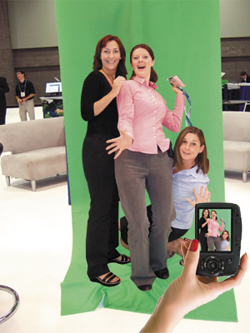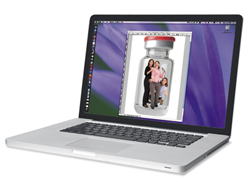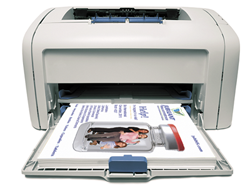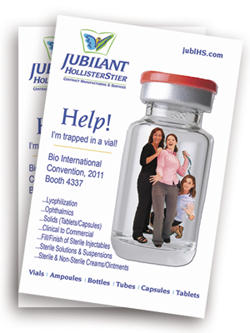Do it Yourself
Sometimes it's easier — and cheaper — to do things yourself rather than hire a professional. Here are three tasks you might want to consider bringing in house to save a few bucks.
 Clean Your Carpet Clean Your Carpet
Paying to have booth carpet vacuumed daily might seem inexpensive, but it adds up over time. If you pay $0.35 per square foot for a 30-by-30-foot booth at a three-day show, that's $945. If you do 10 shows a year, that's $9,450. Instead, purchase a vacuum for about $150, do it yourself, and save $9,300. Or if you have a 10-by-10, you can reduce the need for regular vacuuming services by using an inexpensive lint remover to touch up your carpet between cleanings.
 Arrange Your Shipping Arrange Your Shipping
It's not unusual for exhibit houses to levy a surcharge of 25 to 30 percent of your shipping cost as a turnkey fee for managing transportation. So the most cost-effective choice is obviously to arrange it yourself. Granted, it will take more of your time, but if you work with a reputable, experienced, trustworthy transportation firm, you could save a lot of dough by cutting out the middle man and related turnkey fees.
 Design Your Graphics Design Your Graphics
When it comes to designing your graphics, don't overlook in-house talents such as designers or copywriters. Using their skills can all but eliminate creative costs, leaving only production charges. Plus, given internal employees' understanding of your company, its products, and your marketing efforts, they can usually speed the design process as well.
|

Within the last decade, do-it-yourself projects have gone from something only Bob Vila and Martha Stewart did to á-la-mode activities that saturate Home and Garden TV. It's cool to repurpose barn wood, it's hip to retile your bathroom floor yourself, and it's trendy to make your own garden trellis. And doing things yourself isn't just on trend; it's also cost effective. However, while DIY jobs are fine for handymen and handy ladies working on personal projects, exhibitors don't typically clamor to incorporate DIY elements into their booths.
In that case, Shannon Jordan is not your typical exhibitor. With the title of marketing manager, it's her job to orchestrate five to six annual trade shows for Jubilant HollisterStier's Contract Manufacturing and Services Division (JHS), which manufactures multidosage drugs and sterile injectables for pharmaceutical and biotech companies. With manufacturing facilities scattered across the United States, Canada, and India, and clients in more than 90 countries, JHS is considered one of the top five contract manufacturers in a highly competitive industry. But even as an all-star player in the pharma field, the company only coughs up pill-sized budgets for its trade show presence. "JHS doesn't allocate much money for shows," Jordan says. "This makes things interesting by challenging me to be
really creative, doing more with less."
JHS has been exhibiting since 1999, at shows wherein the booth functioned solely as a space where company reps held meetings with clients. When Jordan was hired in 2008, she made a point to change that. "In this industry, it's hard to differentiate yourself from the competition because everyone has to work within federal guidelines. I wanted to find creative ways to provide brand awareness while 'coloring' inside the guidelines."
A Dose of DIY
As Jordan prepared for the Bio International Convention, she was determined to give attendees a memorable experience and a lasting takeaway that would help differentiate JHS from the other exhibitors. But how?
 |
|
To drive traffic to the booth, Jordan made 3-by-8-foot signs and placed them next to the convention center's Internet cafes. The signs read, "Get your photo taken trapped in a vial." |
As it turned out, the solution came from an unlikely source. After noticing the popularity of photo booths at shopping malls, Jordan started paying closer attention. She witnessed people happily standing in lines for upwards of five or 10 minutes to get their pictures taken. Furthermore, Jordan's gut told her that participants likely held on to those snapshots much longer than other, less personal mementos. Suddenly, she had her own flashbulb of an idea. JHS could bring a photo booth to the show floor. But instead of dropping a fortune on rental costs, Jordan determined she could save money with a little finessing.
The idea was simple and inexpensive — it had to be since Jordan would purchase all the materials herself and run the promo single-handedly while JHS reps met with clients. Dubbed "Trapped in a Vial," the photo op followed a basic process: Jordan would snap attendees' pictures in front of a green screen; then she would import the attendees' photos into an empty glass-vial template on her computer, and print copies of the "trapped in a vial" photos for attendees to take with them. Since the bulk of JHS's business comes from sterile injectable manufacturing, the vials were the perfect visual reminder of the company's products.
 |
| As attendees entered the booth, Jordan invited them to pose in front of a green screen while she snapped their photos with her digital camera. |
"Our goal was to drive traffic to the booth and have visitors leave with tangible information about the company, as well as a great memory of our brand," Jordan says. Additionally, she hoped the promotion would attract 100 attendees per day, generating at least 30 qualified leads by the end of the three-day show.
Jordan's promo expenses were miniscule compared to her sizeable goals to keep JHS top of mind with clients. An inventory of her expenses included a box of 4-by-6-inch photo paper ($20), a secondhand photo printer ($20), printer ink ($50), a green screen and computer software to create the images ($250), and three foam-board signs promoting the photo op ($200). It was a roll-up-your-sleeves DIY deal, and Jordan was eager to find out how the in-booth promotion would be received.
Promo Prescription
When the Bio International Convention opened its doors, more than 15,000 attendees flooded the show floor. Because Jordan didn't have any spare cash to invest in an elaborate pre-show promo to build hype, she made sure that her company's booth was located in the front of the exhibit hall on a highly trafficked corner. This would enable her to flag down as many passersby as possible.
 |
|
Jordan uploaded photos from her digital camera to her laptop, and imported them into Photoshop. Then, she used Green Screen Wizard to drop photos of the attendees inside an image of a clear vial. |
In addition to a well-placed booth, Jordan produced two 3-by-8-foot signs and got show management's approval to place them next to one of the convention center's Internet cafes. The signs read, "Get your photo taken trapped in a vial" beside JHS's name and booth number. "This could be you!" the signs read, with an arrow pointing to a glass vial with a tiny person crouched inside. The bottom of the signs added that attendees who had their photos taken would be entered into a drawing to win a $500 Visa gift card.
As attendees approached the 20-by-20-foot JHS exhibit, Jordan called out to them like a carnival barker, "Step right up! Get your picture taken trapped in a vial!" She directed curious attendees to stand in front of a 4-by-20-foot green screen, instructed them to look scared and trapped, and snapped a photo with her digital camera. Next, she imported the photos onto her laptop and used Photoshop and an easy-to-use program called Green Screen Wizard to drop images of the attendees inside an image of a clear vial.
Using a color printer, Jordan then printed 4-by-6-inch photos with the words "Help! I'm trapped in a vial!" beside the JHS logo, Web address, and a list of the company's services. As attendees waited for their photos to be printed, Jordan collected their contact info, which served as their entry to win the $500 gift card.
 |
| While attendees chatted with sales reps in the booth, Jordan printed their photos on 4-by-6-inch branded cards that read, "Help! I'm trapped in a vial!" |
Start to finish, the entire process took about five minutes, and afterward, attendees who were interested in learning more about JHS were directed to speak with one of the four company representatives on hand.
But all that hard work paid off. JHS met its goal of interacting with approximately 100 attendees per day of the show, totaling more than 300 exchanges. In fact, according to Jordan, the promotion tripled JHS's booth traffic, helping her surpass her second goal of obtaining 30 qualified leads.
"The big ROI was brand awareness," Jordan says. "The truth is that in our industry, we're not going to land multimillion-dollar clients because we snapped a picture of them. But they'll remember us, and that counts for a lot."
 |
| The finished product featured the "trapped in a vial" photo, the company's logo and Web address, and a list of JHS' other product offerings. |
Vials Gone Viral
It does indeed count for a lot. Jordan has put her "Trapped in a Vial" promo to use at nine shows since its debut. "People know it by now, but they still love it," Jordan says. "I think there's an endless number of people who want these images."
Countless attendees eager to get their hands on a memorable photo has meant substantial brand awareness for JHS. And most impressive of all, Jordan is still utilizing her original
materials for the promo, simply replenishing the photo paper, printer ink, and printed signage before each show. After the initial expenditure, Jordan calculates that her per-show cost is a mere $150, plus the $500 Visa gift card drawing held on the final day of each show.
"Our organization has grown exponentially over the years, and there's no question that our trade show presence supports our overall efforts to reach current and potential clients," Jordan says. "It's great to know that this promo is dispersing our branding to many different groups."
In 2012, JHS secured contracts with four companies for the commercial manufacturing of sterile parenteral products for sale in the Europe and U.S. — a deal valued at $90 million. While Jordan certainly doesn't believe her in-booth photo activity can take all the credit, the promo goes to show that a little creative DIY can contribute to a very impressive ROI. E




 Clean Your Carpet
Clean Your Carpet

 Within the last decade, do-it-yourself projects have gone from something only Bob Vila and Martha Stewart did to á-la-mode activities that saturate Home and Garden TV. It's cool to repurpose barn wood, it's hip to retile your bathroom floor yourself, and it's trendy to make your own garden trellis. And doing things yourself isn't just on trend; it's also cost effective. However, while DIY jobs are fine for handymen and handy ladies working on personal projects, exhibitors don't typically clamor to incorporate DIY elements into their booths.
Within the last decade, do-it-yourself projects have gone from something only Bob Vila and Martha Stewart did to á-la-mode activities that saturate Home and Garden TV. It's cool to repurpose barn wood, it's hip to retile your bathroom floor yourself, and it's trendy to make your own garden trellis. And doing things yourself isn't just on trend; it's also cost effective. However, while DIY jobs are fine for handymen and handy ladies working on personal projects, exhibitors don't typically clamor to incorporate DIY elements into their booths.








